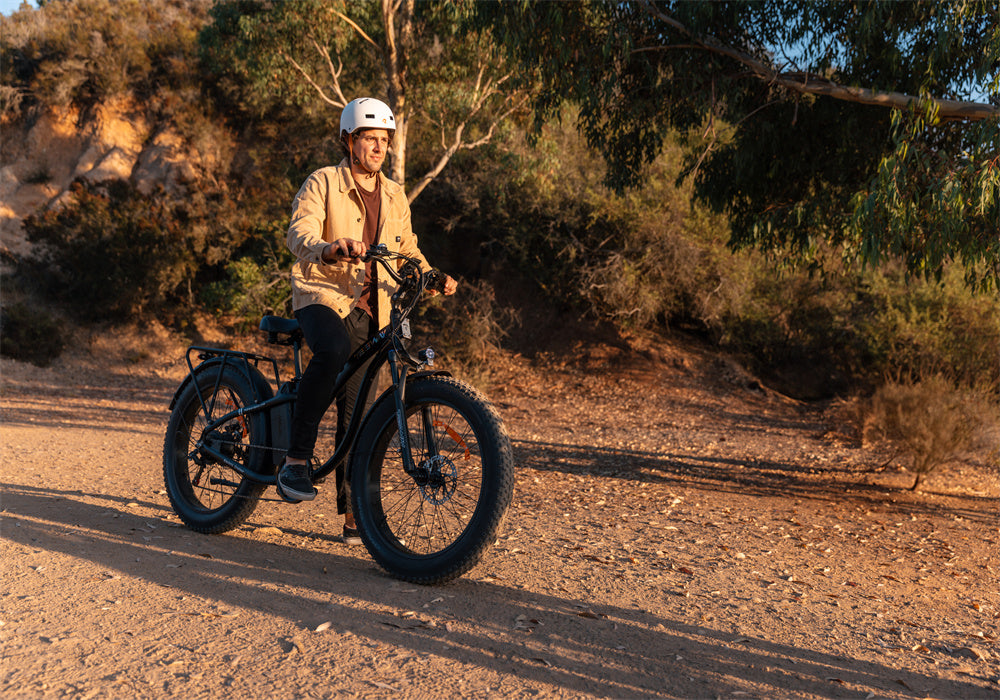Mechanical and hydraulic disc brakes are the two main types of braking systems found on bicycles today.
Mechanical Disc Brakes use cables to transmit the force from your brake lever to the brake caliper. When you squeeze the brake lever, it pulls a cable that moves the caliper, which then presses the brake pads against the disc rotor attached to the wheel. This friction slows down and stops the bike. Mechanical disc brakes are quite simple in design.
They are easy to set up, adjust, and maintain. If a cable gets worn out or frayed, you can replace it quickly without too much hassle. However, they do require regular tuning to keep the cable tension just right and ensure the pads are properly aligned with the rotor.
Hydraulic Disc Brakes use fluid to transfer the force from the brake lever to the brake caliper. When you pull the brake lever, it pushes fluid through a sealed line, which then moves pistons in the caliper. These pistons push the brake pads against the rotor, slowing the bike down. Hydraulic disc brakes provide more consistent and powerful braking.
They automatically adjust for pad wear, so you don't have to tweak them as often. They need less force at the lever, making them easier on your hands, especially during long rides. The Tesway x5 folding electric bike with hydraulic brakes is perfect for long distance riding. However, they are more complex. Setting them up and maintaining them can be trickier, and if a hydraulic line gets damaged, it's a bit more involved to fix compared to a cable.
Are Disk Brakes Essential for Electric Bikes
Disk brakes are pretty much a must-have for electric bikes.
Better Stopping Power
Electric bicycle are generally heavier and can go faster than regular bikes. Disk brakes provide the strong stopping power needed to handle that extra weight and speed. Whether you're cruising at high speeds or just navigating through busy streets, disk brakes ensure you can stop quickly and safely when you need to.
All-Weather Performance
Disk brakes shine in all types of weather. Unlike rim brakes, which can lose efficiency in the rain or mud, disk brakes maintain their performance no matter what. This reliability is crucial for e-bike riders who often use their bikes for commuting and can't afford to have their brakes fail in bad weather.
Durability
Eletric bicycle put more stress on their braking systems due to their weight and speed. Disk brakes are built to last under these tougher conditions. They don't wear out as quickly as rim brakes, meaning you spend less time and money on maintenance and replacements.
Modern Design
Many of today's e-bikes are designed with disk brakes from the get-go. This integration means the bikes are optimized for disk brakes, giving you the best performance and safety features right out of the box.
How Do I Know if My Brake Discs Are Bad
It's crucial to keep an eye on your brake discs to ensure they are in good shape.
Visible Damage
Take a close look at your brake discs. If you see grooves, cracks, or warping, it’s time to replace them. A smooth, even surface is key for effective braking.
Reduced Braking Power
If your bike isn’t stopping as quickly or efficiently as it used to, your brake discs might be worn out. This reduction in braking performance can be dangerous, so don't ignore it.
Strange Noises
Listen for unusual sounds like squealing, grinding, or rubbing when you apply the brakes. These noises often mean that the brake pads are rubbing against a damaged or uneven disc surface.
Vibration
If you feel a vibration or pulsing in the brake lever or pedal when you apply the brakes, this could be a sign of warped brake discs. Warped discs don’t make even contact with the brake pads, leading to these vibrations.
Excessive Pad Wear
Check your brake pads. If they’re wearing out faster than usual, your discs might be rough or uneven, causing more friction and quicker pad wear.

How Much Does It Cost to Replace Car Brake Discs
The price of the brake discs themselves can range widely. For most standard vehicles, you can expect to pay anywhere from $30 to $100 per disc. If you need high-performance or specialty discs, the cost can go up to $300 or more per disc.
Labor costs will also vary based on where you live and which shop you choose. On average, you might pay between $100 and $200 per axle for the labor to replace the discs. High-end shops or dealerships might charge more.
Combining parts and labor, replacing brake discs on one axle (both front or both rear wheels) will typically cost between $150 and $400. If you need to replace the discs on all four wheels, the total cost could range from $300 to $800 or more.
Sometimes, additional parts need replacing as well. If your brake pads or calipers are also worn out, you'll need to factor in the cost of those parts and the extra labor. It’s also a good idea to check your brake fluid and potentially replace it during a brake job, which can add to the overall cost.
Conclusion
For electric bikes, disk brakes are indispensable due to their enhanced stopping power, reliability in all weather conditions, and durability. They ensure safety and efficiency, which are paramount for the heavier and faster nature of e-bikes.
FAQs
What is brake pad contamination, and how can it be prevented?
Brake pad contamination occurs when substances like oil, grease, or dirt get onto the brake pads or rotor, reducing braking performance. To prevent it, avoid touching the rotor and pads with oily hands, and keep your bike clean. If contamination occurs, clean the rotors with isopropyl alcohol and replace the pads if necessary.
Can I upgrade my existing bike from rim brakes to disc brakes?
Yes, you can upgrade from rim brakes to disc brakes, but it requires significant modifications. You'll need compatible wheels, frame, and fork, along with the disc brake system itself. It's often more cost-effective to buy a new bike with disc brakes already installed.
What is brake pad contamination, and how can it be prevented?
Brake pad contamination occurs when substances like oil, grease, or dirt get onto the brake pads or rotor, reducing braking performance. To prevent it, avoid touching the rotor and pads with oily hands, and keep your bike clean. If contamination occurs, clean the rotors with isopropyl alcohol and replace the pads if necessary.







Share:
Comprehensive Bike Size Chart: Find the Perfect Fit for Your Bike
Folding Electric Bike Pros and Cons Explained: What You Need to Know